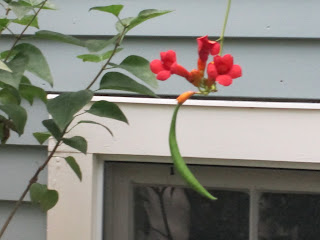A huge trumpet vine grows two stories up and over our detatched garage-- it's so heavy that it fell after a heavy rain. We put it back up and I think it will be okay. I can see it from my favorite spot on the deck and I love to watch hummingbirds dive into the flowers and perch on top of them. (Sorry--no hummingbirds in my pictures.) Luke and I were admiring them and I was trying to remember what I'd read about hummingbirds--how fast they fly, how many babies can fit on your little fingernail,..
All these books are piled up next to my desk because I'm writing (or, more accurately, trying to write) a collection of personal essays about nature.
My favorites have always been the narratives, the personal stories, but I am trying to read more "about" books, to learn something new every day.
The ruby throated hummingbird weighs approximately 1/10 of an ounce. When hovering, their wings beat 55 times per second. Those two facts alone, fill me with wonder. And they can fly backwards.
Now I need to find out why trumpet vines have such large seed pods.







I love trumpet vines, keep trying to figure out where I could plant one. I love your color. The hummingbirds love my daylilies, I'm always in awe of them as they flap away while feeding on the flower then they're gone. In Spanish they're called zum zum (I think it's slang), wonder why.
ReplyDeleteHummingbirds have to be the most beautiful little birds ever. We dont get them over here in england but were lucky enough to see them when we visited Vermont for our honeymoon and Palm springs for my husbands 50th birthday. I count myself very fortunate to have seen them.
ReplyDeleteI found out you don't also have the whippoorwills I wrote about earlier. But you have many wonders that we don't! Reading your and other peoples blogs has expanded my wish list to include driving tours of England and Ireland, a trip to Budapest and one to Australia.
DeleteHello Jen:
ReplyDeleteSuch a lovely idea to be writing a series of personal essays based on the natural world. We should think that you are particularly well equipped for this on account of your in depth knowledge, your keen eye, and your inherent interest in your subject.
We leave for Venice, to which we go often, this evening so will be away from the computer for a few days.
Oh Venice...Wish I was going too. Have fun!
DeleteWhen I saw some tiny little bird-like creature hovering around flowers, a friend of mine said it was a hummingbird. I was wondering if there was a hummingbird here. I knew it was a "houjaku"(sphingidae, a kind of moth).
ReplyDeleteI'd like to see real hummingbirds some day.
All birds are wonderful, but hummingbirds seem a bit exotic to me. Captivating.
DeleteGood for you,writing again.
ReplyDeleteOdd, that hummingbirds don't get to Europe. But in my readings a while back, I discovered that when hummingbirds were discovered in the Americas, they would be killed and their jewel-like feathered skins turned into brooches for French ladies, and probably for the rest of Europe, too. This was in the 17th century . . . and maybe earlier.
I've heard those hat stories too--lots of wildlife was sacrificed for style! Didn't know about brooches. That's a little creepy.
DeleteHere in Japan less number of sparrows are observed...There are some reasons, less paddy fields and less suitable eaves...Nature has its own law.
ReplyDeleteAnd sometimes good and unexpected things come of what we perceive as bad.
DeleteHello Jen, Those stacks of nature books are useful for reference and inspiration, but can never be definitive, and only underscore the need for personal observations and photographs like yours. Nature is different in every microcosm, and also keeps changing.
ReplyDelete--Road to Parnassus
I am trying to do more of both these days--more focussed observation and book learning. I fear I will never be a good photographer, but have found that lioking at my pictures helps me see things differently.
Deletei hadn't known about the fungus and the bats. I'm like you, I always need to read up on things and to find out. like why cockatoos and galahs always hang out together. do you know?
ReplyDelete:)